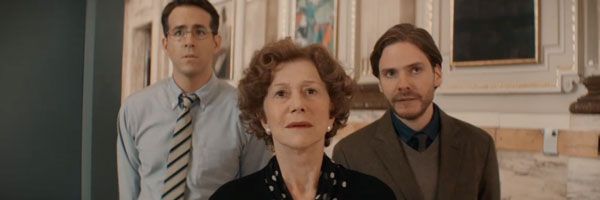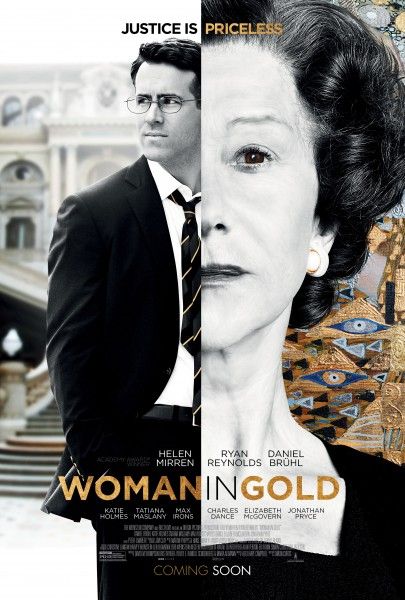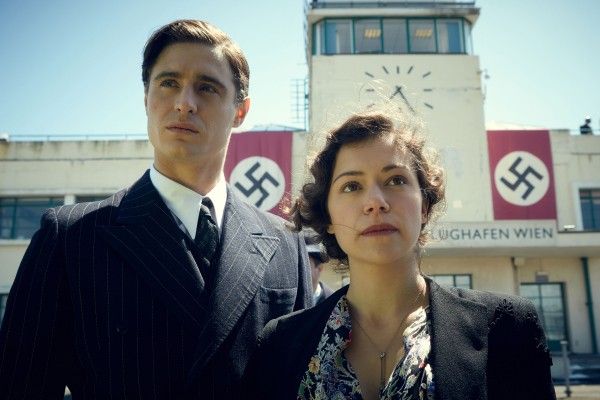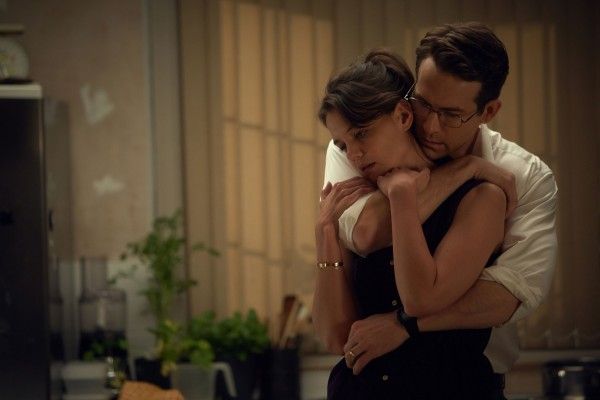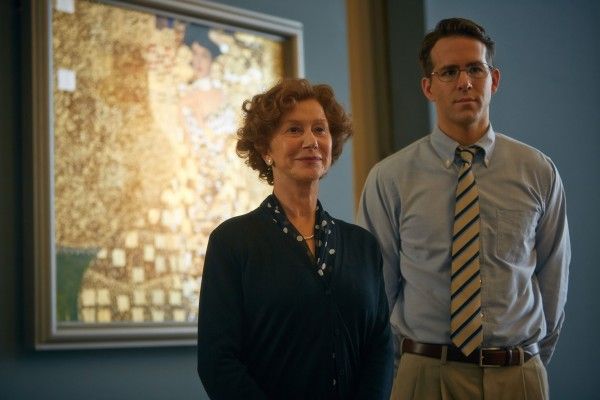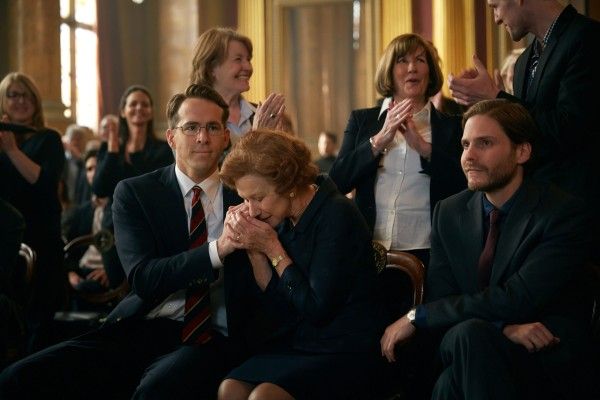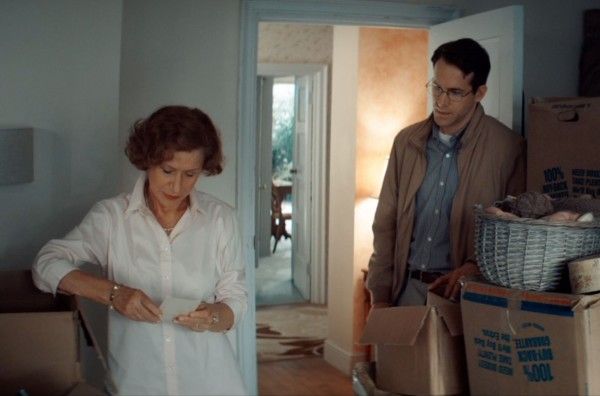Simon Curtis’ Woman in Gold is a beautifully crafted, fact-based drama about one woman’s courageous journey to reclaim her rightful heritage and seek justice for what happened to her family during World War II. Maria Altmann (Helen Mirren), an elderly Jewish woman, sets out to recover artwork that includes Gustav Klimpt's iconic portrait of her beloved Aunt Adele stolen from her family during the Nazi occupation of Vienna. With the help of an inexperienced but tenacious young lawyer, Randy Schoenberg (Ryan Reynolds), she confronts difficult truths about the past that will take her case all the way to the U.S. Supreme Court and beyond.
In an exclusive interview, Curtis explained why this was a great story of the 20th century, his collaboration with screenwriter Alexi Kaye Campbell, the inspiration he drew from his immigrant experience, the emotional intensity of recreating on film the demise of the Jewish community in Vienna, why it’s important to remind a younger generation of the tragedy suffered, what his impressive cast brought to the project, how the production challenges resembled 3D Sudoku, the film’s visual style, Hans Zimmer’s thrilling score, Harvey Weinstein’s passion for the project, and his upcoming feature project, The Chaperone, scripted by Julian Fellowes. Check it all out in the interview below.
Question: What was it about this story that made you say I’ve got to make this film?
SIMON CURTIS: I saw a documentary and I just thought it was a great story of the 20th century, spanning the golden years in Vienna at the beginning of the century and ending in America at the end of the century. I’m from a Jewish family in the U.K. so I understood the immigrant experience and so on. I thought it out and I’m very proud it got as far as we’ve got.
The story is told in a smart, coherent and economical way that’s very engaging. Can you talk about recruiting Alexi Kaye Campbell to write the script and what he brought to the project?
CURTIS: I’m really glad you think that. He was a playwright very well known in the U.K. and he’d done a lot of work that spanned different time periods. He was brave enough to take on what is quite a dense and complex story and turn it into something hopefully accessible and entertaining.
How hard was it to get a script with this kind of complicated premise and narrative strands in different time periods to the place to make it all happen?
CURTIS: I would say it was very hard. We went through a lot of drafts over a lot of years. It worked as it usually does. We met. I’d give notes. He’d go away and do another draft.
How did your own background and family roots inform your approach?
CURTIS: I suppose there are certainly women in my family who remind me of Maria or the other way around. I feel connected to my family’s past but don’t know too much about it. I was very struck when I read about it that Maria’s wedding was the last big Jewish social event before the Nazis arrived in Vienna. I felt that was very powerful, that sense of this mighty family and that its days were numbered.
What was it like for you recreating the end of the Jewish community in Vienna?
CURTIS: It was very intense actually and emotional for us all.
Was it important to spread awareness about events that have not been highlighted in the past to remind people of the tragedy suffered on so many levels?
CURTIS: I think that is the main theme of the film to be perfectly honest. It’s like people forget, especially the young, that these terrible things happened for us very recently. And then, of course, the film has landed at the time where it seems unfortunately very timely.
You have a fantastic cast. Why were these the best actors to tell your story?
CURTIS: Because they’re impressive. You see that with Helen Mirren. You want a very strong, very intelligent human actress to play that part. Helen was very brilliant. She’s what’s called an actor magnet. In other words, if she’s in the cast, a lot of other people want to work with her. And with Ryan Reynolds, we wanted Ryan to be like this all-American guy who goes on this journey of discovery. Ryan is a really smart man and really witty and empathetic. And those are the qualities I saw in his character, Randy, too.
In a film that’s about identity, I liked how the actors spoke German in the flashbacks rather than accented English.
CURTIS: Yes, that was very important to me, very important to me, because it just wouldn’t make sense if it was English spoken with a German accent. Maria was born in Vienna and taught in German, and she died in California speaking English. That was a huge part of the reinvention.
Was that difficult to achieve with your cast?
CURTIS: It was definitely an issue because we had English actors speaking German, and German actors speaking English, and German actors speaking English with an Austrian accent. There were all kinds of issues. Fortunately, I had a very brilliant person helping us with the accents, a woman called Susi Stach, the dialect coach who had helped Daniel Brühl with his accent for Rush. We seemed to have made it work. So, I’m very proud of that.
What were some of the other production challenges you encountered shooting in three countries, two languages and three time periods?
CURTIS: Well exactly. There you go. That’s what it is. The schedule was a bit like 3D Sudoku because we have to cast somebody and then work out that they have one day in London and one day six weeks later in L.A., or one day in Vienna and three days in London. I mean, it was all of that because that’s the way the scenes broke down. Where there’s a will, there’s a way, and we sort of made it work.
Were there any surprises, good or bad?
CURTIS: I was surprised how, you know, I thought it would be impossible to direct a language I didn’t speak, but somehow it worked. It was a very, very happy shoot and everybody on both sides of the camera was as committed to the story and the characters as I was.
Was there additional research that you did in preparation for this?
CURTIS: Of course, I did everything I could to learn about Vienna in those years and what happened when the Germans arrived. Neither Helen nor I met Maria, but we studied the many hours of videotape of her and so on. So, we did everything we could.
Was it difficult striking the right balance between drama and humor in the characters’ relationship? I know some of it is in the script, but I thought you did a terrific job bringing that out in your actors.
CURTIS: I wouldn’t say it was difficult. It was certainly true that they enjoyed doing some comedy improv during and after scenes. I saw that and I said, “Let’s get that in the can,” because you never know if that will land right to that moment in the film or not. So, what you do is you get yourself as many options as possible in the cutting room and then you try and get the balance right then.
I’m a native Angeleno and I loved the way you shot L.A. There were a lot of nice moments.
CURTIS: I’m really pleased because we wanted the non-Hollywood L.A. My parents-in-law live in Encino so I knew that area very well. We shot Randy’s house in Encino and we shot in Balboa Park. So, I was trying to make it feel like that’s the way it really is in L.A. I’d read that Maria used to go to Norm’s so we put that in.
The flashbacks convey vividly the rich culture, the experiences and memories of these characters. Can you talk about what influenced your visual style?
CURTIS: That’s exactly right what you’re saying. I was very influenced by Fanny and Alexander, the Ingmar Bergman film. There was all that family crammed into that ornate apartment within this very cultured world, and I was influenced by that. And then, we decided the three time periods should each have a different color scheme: the golden years for Adele Bloch-Bauer, the slightly desaturated look in 1938, and the more colorful, more documentary, modern themes.
Your musical choices and the score are very compelling. What was your collaborative process like with your composers, Martin Phipps and Hans Zimmer?
CURTIS: They lived in different countries, too. So, that was an issue. But they got on very well. I’m thrilled with the score. Initially, I worked with a temp score, and then they both joined in post. It’s like everything else, it’s a collaboration with my ideas and their ideas, Harvey’s ideas, the producer’s ideas. We wanted it to be more like a modern Social Network score than a period drama score, if that makes sense, and emphasize the thriller-ness of it. I wanted something that was an homage to the Jewish musical tradition as well. So, we were trying to get a balance of all of that.
How does the final film compare to what you originally envisioned?
CURTIS: What you do is you just do every scene as well as you can. And then, in the cutting room, you have that version of it and you keep refining it. You show it to people. You listen to people. Some things you agree with. Some things you don’t agree with. The final version is the film I envisaged, if that makes sense.
Did you have any friends and family screenings?
CURTIS: Yes, many actually. We had test screenings in New York and Pittsburgh. I will have shown it to thousands of people by the time it’s released. We were always very encouraged actually. I mean, the test screenings were very positive. We’re all very excited.
Can you talk a little about Harvey Weinstein’s passion and support for the project?
CURTIS: Obviously, I’d worked with him on My Week With Marilyn, and he and I have similar tastes because both these films started as my passion but they soon became his passion, too. Both these stories mean as much to him personally as they mean to me. When he’s on your side, it’s very exciting because he’ll say, “Your movie needs the best composer. It needs to be Hans Zimmer because he’ll be fantastic.” Suddenly, Harvey’s made a call to Hans Zimmer, and lo and behold, he’s your composer. It’s that sort of thing and it’s very exciting.
What do you hope an audience will take from this film?
CURTIS: Well, I hope they’ll enjoy it and find it thrilling, but also it will be a think thing as well. They’ll think about their own paths to how they live where they live and what their ancestors went through to live with them, those lives.
What are you working on next that you’re excited about?
CURTIS: I can’t really say because I don’t really know. I mean, there are some things in early stages, but I just want to see this film through first.
Is The Chaperone still happening with Elizabeth McGovern and is Julian Fellowes writing the screenplay?
CURTIS: Yes, that’s a feature project. You just try to move things along and then those films have their own momentum.
Woman in Gold is now in theaters.

